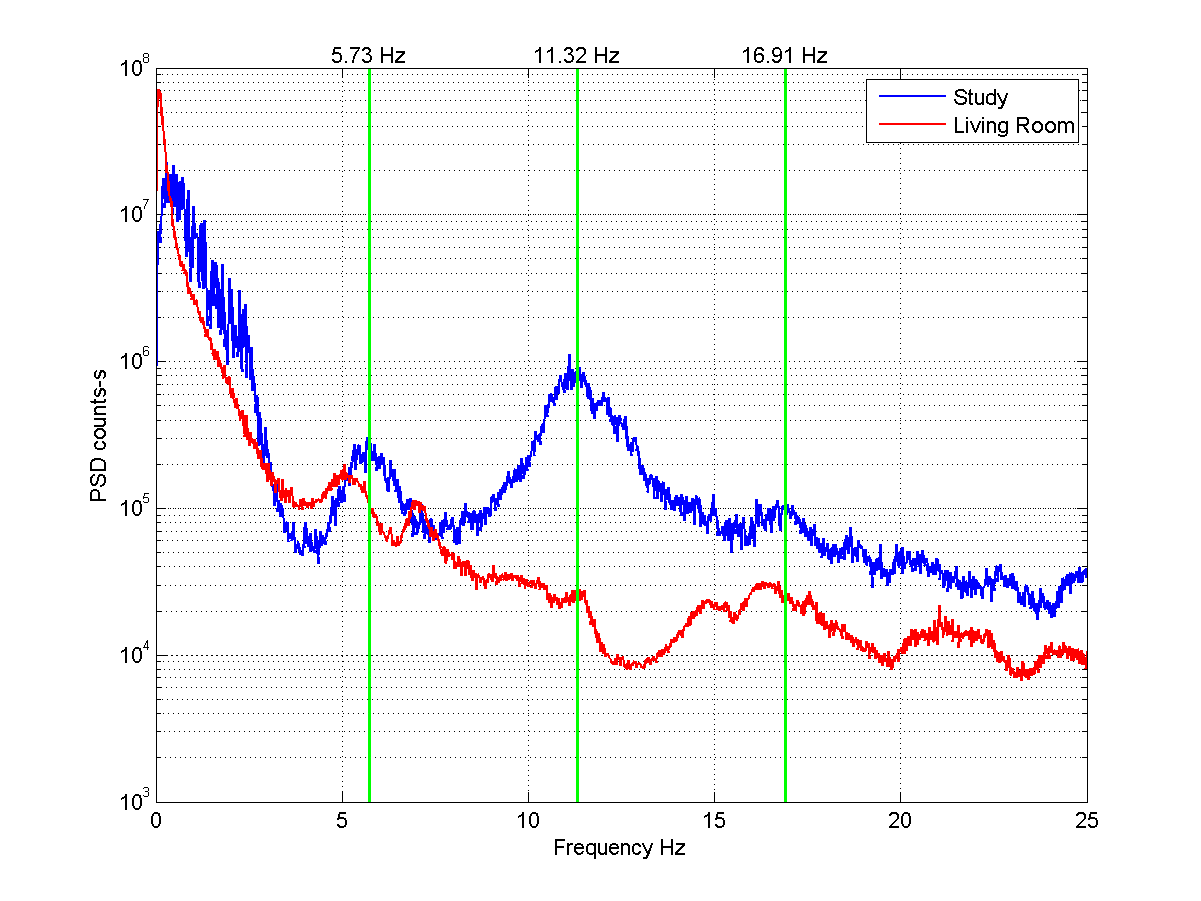Have a look at the RBOOM record from a quiescent period below. The instrument is in our beach cottage, with everything electrical turned off except for the Boom and an RS alongside it. There are houses 50 m away, but they’re unoccupied at present. It’s a very quiet place.

In the spectogram, you can see a background hum at 12.4 Hz.
But when an event occurs (a wind gust perhaps), the hum increases in energy.
In my field (tsunami propagation) , we would call this “seiche” or resonance: an embayment or harbour oscillates quietly at its natural frequency, but when a wave or waves come in that contain a range of frequencies, the natural frequency gets amplified many-fold preferentially. It’s a primary cause of inundation from tsunami.
Can someone interpret the hum in the Boom signal for me?
Is it something in the instrument itself?
Or is it a natural phenomenon? If so what can it be?
3 Likes
I’d presume the structure (beach cottage?) or some portion of it resonates at that frequency.
According to https://vibrationdamage.com/resonance_and_fatigue.htm
" For whole home vibrations, the resonance frequency (sometimes seen referred to by scientists as the “eigenfrequency”) is in the range of 8-12 Hz , typically."
I have my RBoom outdoors with the input connected to 50 feet of porous “soaker hose” extending along the ground, and now somewhat covered by vegetation. I do not see any resonance-like feature anywhere near 12 Hz on that system. At times I do see specific frequency signals from various neighboring houses whenever their HVAC systems run, but those have clear on/off transitions.
2 Likes
But if the structure was oscillating, shouldn’t I see it in the RS that’s alongside the Boom? The RS has white noise (flat spectrum) above 4 Hz.
Is it possible it’s the air in the room that is oscillating? The room is roughly 2.4 m cube, with the Boom on the concrete floor in the middle of one side.
I’ll try moving the Boom into the other wing where the room size is larger and the floor is fibreboard on 1 m high wooden piles…
1 Like
This sounds like the setup to a fluid mechanics problem. Have you checked to make sure there’s not another resonance band above at either 24 or 36 Hz?
There’s nothing discernible in the spectrum at the higher frequencies.
I’ve just checked the record when I had the Boom at home and it shows no resonance at 12.4 Hz, so that eliminates instrument noise and confirms that it is site specific.
BTW, I have read that infra sound is associated with supernatural phenomena. Perhaps we have a ghost at our beach house?
Houses do have resonances but you need something to “excite” the resonance to see it.
For these mysterious “tones” OSOP have pointed the finger at RF interference, but I am not so sure (since my unit is well-shielded/filtered). It may be that some of these “tones” are an artifact of the A/D converter at different operating conditions. Or it is noise being generated by the R-PI operation and picked up by the A/D board and its sensitive amplifier. The emissions from the RPI’s digital circuits are many/varied/unpredictable.
I and a buddy (25 miles apart) are both seeing a continuous 34 Hz “tone” this morning and when the Canadian quake came through, we observed that it “modulated” the 34 Hz tone
“in sympathy” with the stronger part of the quake input, at both of our stations.
This is obviously a fictitious signal and we understand that it should just be ignored. It is pretty interesting that the real signal had an impact on this spurious signal though. I don’t think I have seen that before.
Tones with a real mechanical cause (HVAC related for example) of course will tend to stop and start or vary in amplitude and not just run 24/7 at a constant amplitude, in my experience.
==========
OK - edit: I went back a month or so and found my RBOOM was doing something similar to yours. In this case it was about 10 Hz and strong signals below 10 Hz were being “replicated” above 10 Hz.
The loud sounds are door open/close events.
This nonsense largely went away when I sealed-up the box and moved the unit out-of-doors. I suggest you do the same 
Well, I guess it depends on the reason for having a Boom in the first place.
For me, looking at sources of infra sound within my living environment is more interesting than waiting for the rare happenstance of a bolide or nuclear blast.
And the trouble of getting the instrument up and working outside just to measure, well, nothing really for most of the time, doesn’t seem worth it.
But each to their own. 
1 Like
Depends on your environment. I have three school-age children living here. After school let out for the summer, we often exceeded 70 door-slams per hour. I soon grew tired of looking at my “living environment.” 
There are a lot of interesting things going on out-of-doors without meteors or nukes …
I moved the Boom from the study (a 2.5 m cube) to the living room (5m x 4m space) to see what effect the room size had and here are the spectra:
These have been calculated from a day of record, using 10 min windows and frequency averaging with side lobes of 5 points.
The study has a concrete floor, whereas the living room is fibreboard on 1 m high wooden piles.
Evidently there is oscillation in the study at 5.73 Hz and higher harmonics that is not replicated in the living room.
In the study, the Boom was at the wall on one side. If I put it in the very middle of the room, will it be at a node, where the amplitude is zero? I’ll try it.
3 Likes






